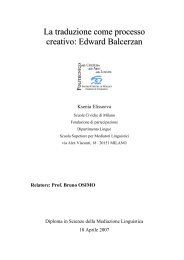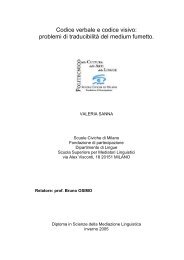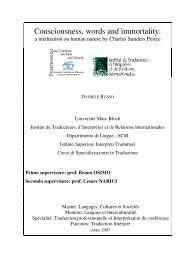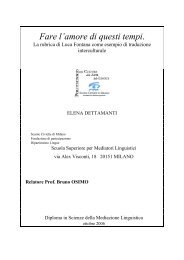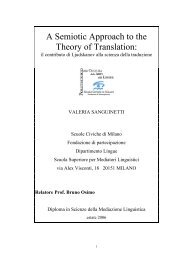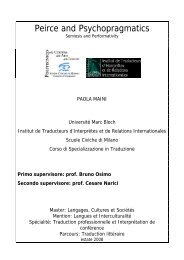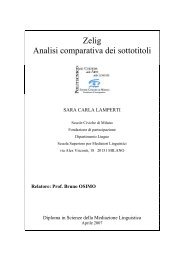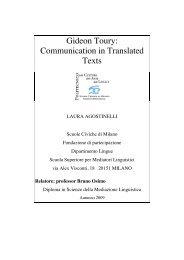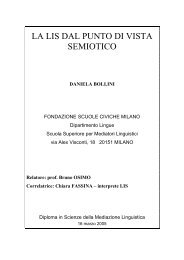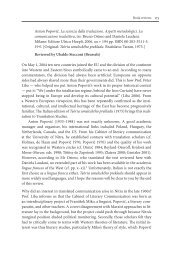Ksenia Elisseeva - Bruno Osimo, traduzioni, semiotica della ...
Ksenia Elisseeva - Bruno Osimo, traduzioni, semiotica della ...
Ksenia Elisseeva - Bruno Osimo, traduzioni, semiotica della ...
You also want an ePaper? Increase the reach of your titles
YUMPU automatically turns print PDFs into web optimized ePapers that Google loves.
Even if we disregard the variants generated by the order of the cards within the<br />
group and consider only the possibility that cards in the deck have of being the<br />
person's card, or of being in groups like “on the heart”, “what was”, “what is”, or<br />
“what will be”, then according to the formula of combinations the number of<br />
plots will be equal to 12•10 22 . Taking into account all the variants arising from<br />
diverse arrangements or permutations of cards within each of the peripheral<br />
groups, this number must be multiplied yet another one hundred times and<br />
becomes twelve septillions or 12•10 24 . If the three billion inhabitants of the<br />
terrestrial globe were each to make a new distribution of cards every minute,<br />
they would exhaust all the variants after ten billion years of uninterrupted labor;<br />
but it is calculated that the solar system will only last approximately another<br />
eight billion years, and certainly people will find themselves more interesting<br />
and important pursuits during this period.<br />
Moreover, the enormous number of plots are created by thirty-six cards,<br />
a very limited set of signs. Hence arises one of the cardinal questions of the<br />
theory of plots, that of the “primary element”. On the basis of the material of<br />
folklore and of ancient and medieval literature, the academician A. N.<br />
Veselovskij suggested that the primary plot element is the motif, «the simplest<br />
narrative unit which responds figuratively to the diverse inquiries of the primitive<br />
mind or of everyday observation» (Veselovskij 1940: 500). An eclipse of the sun<br />
and abduction of a girl are typical motifs. V. Â. Propp later set himself the goal<br />
of creating a complete list of motifs of fairy tales by analyzing one hundred plots<br />
from Afanas'ev’s collection of tales. He defined his primary elements more<br />
exactly as functions and obtained thirty-one such functions, including “a<br />
member of the family leaves home”, “a ban is imposed on the hero”, “a ban is<br />
broken”, and so on (Propp, 1968: 25-65). It seems that functions can be divided<br />
into even smaller units such as “hero”, “departure”, “ban”, “antagonist”,<br />
“deception”, and “struggle”, which would turn out to be at least half as few<br />
functions as thirty-one. But the fact remains that such units do not aid us at all in<br />
understanding the essence of the fairy tale, for they cannot be freely correlated<br />
with each other: to wit,<br />
18



